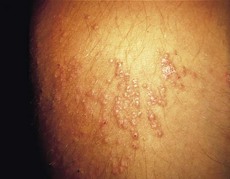174 Eruptive xanthomata
Salient features
Diagnosis
This patient has eruptive xanthomata (lesion) caused by hypertriglyceridaemia (aetiology).
Advanced-level questions
In which conditions are eruptive xanthomata seen?
• Familial hypertriglyceridaemia
• Lipoprotein lipase deficiency
• Apolipoprotein CII deficiency
• Type I hyperlipidaemia: chylomicronaemia
• Type V hyperlipidaemia: increased levels of triglycerides and chylomicrons.
Mention some other causes of hypertriglyceridaemia
• Primary hypertriglyceridaemia (usually >5.0 mg/l): familial hypertriglyceridaemia, familial combined hyperlipidaemia.
• Secondary hypertriglyceridaemia: diet, obesity, excess alcohol intake, diabetes mellitus, hypothyroidism, uraemia, dysproteinaemias, drugs (beta-blockers, oral contraceptives and oestrogens, retinoids).
What is the particular risks for patients with serum triglycerides markedly raised (>10.0 mg/l)?
They are more susceptible to acute pancreatitis and hyperchylomicronaemia.
How would you manage a patient with raised levels of serum triglycerides?
• Diet: restrict dietary fat, decrease intake of alcohol and simple sugars
• Weight loss if the patient is overweight
• Discontinuation of drugs, e.g. beta-blockers
• Niacin, gemfibrozil or omega-3 fatty acids may be used to treat elevated triglycerides (>5.0 mg/l) regardless of LDL or HDL cholesterol.







